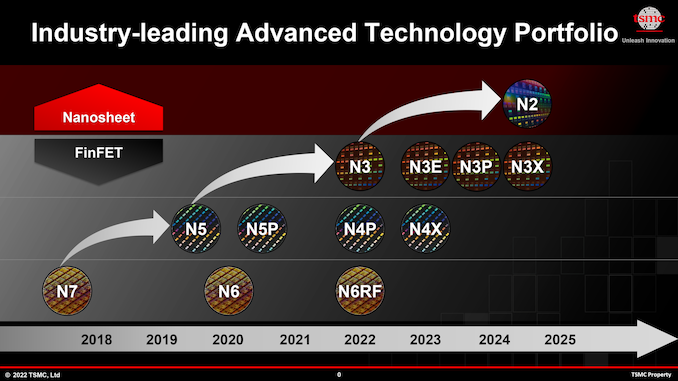TSMC's 2nm chips are coming to a device near you in 2026
3nm to begin volume production later this year.

Taiwan Semiconductor Manufacturing Co. (TSMC) has officially announced its 2nm class process node. It’s set to ship to customers in 2025. The company also revealed more details regarding its 3nm technology, which is due to begin production later this year.
TSMC held its North America Technology Symposium on June 16th. It talked about its advanced technologies, including updates on its various processes and packaging tech. It also outlined its future expansion plans. The highlight for PC enthusiasts was undoubtedly the reveal of its 2nm node—referred to as N2—which includes a shift away from well established FinFET technology to a nanosheet transistor architecture. We can expect to see this tech in our computers in the coming years.
TSMC’s nanosheet technology uses what are known as GAAFETs (gate-all-around field-effect transistors). The aim is to reduce quantum tunnelling effects and leakage, which is a major barrier to further FinFETs scaling. With GAAFETs, these effects are greatly reduced, and Moore’s Law might have some last gasps.
N2 delivers the gains you’d expect to see from a process shrink, including 10-15 per cent higher performance at the same power or a 25-30 per cent lower power consumption at the same frequency and transistor count when compared to TSMC's N3 node.


Best CPU for gaming: The top chips from Intel and AMD
Best gaming motherboard: The right boards
Best graphics card: Your perfect pixel-pusher awaits
Best SSD for gaming: Get into the game ahead of the rest
It’s important to note that node naming schemes are becoming less and less relevant. The move to a smaller node implies smaller transistors and greater density, but TSMC’s N2 node won’t actually impress all that much when measured in those terms, delivering a relatively minor 1.1x density increase compared to the N3E node.
While devices built with N2 products are still a few years away, N3 products are much closer. TSMC detailed five different N3 tiers. TSMC will start with its first generation N3 before tweaking the process with N3E (Enhanced), N3P (Performance Enhanced), N3S (Density Enhanced), and the Ultra-High Performance N3X. The first 3nm chips are set to be shipped to manufacturers at the end of this year.
That would mean N3 won’t be used in Apple’s upcoming iPhone 14, though in 2023, devices with M3 processors are likely. There’s some speculation that Intel may use N3 tiles in its 15th Gen Arrow Lake processors in 2024. AMD’s Zen 5 processors may use it too. As for graphics cards, given that Nvidia and AMD are stretching out their release schedules, RDNA 4 and RTX 50 series cards are certainly at least two years away from release.
Keep up to date with the most important stories and the best deals, as picked by the PC Gamer team.
It’s far too early to speculate about what devices may include N2 products. The companies with the big bank balances will surely be first in line. The usual suspects including Apple, Qualcomm, AMD and Nvidia will be sniffing around. A lot can change in four years though.

Chris' gaming experiences go back to the mid-nineties when he conned his parents into buying an 'educational PC' that was conveniently overpowered to play Doom and Tie Fighter. He developed a love of extreme overclocking that destroyed his savings despite the cheaper hardware on offer via his job at a PC store. To afford more LN2 he began moonlighting as a reviewer for VR-Zone before jumping the fence to work for MSI Australia. Since then, he's gone back to journalism, enthusiastically reviewing the latest and greatest components for PC & Tech Authority, PC Powerplay and currently Australian Personal Computer magazine and PC Gamer. Chris still puts far too many hours into Borderlands 3, always striving to become a more efficient killer.

